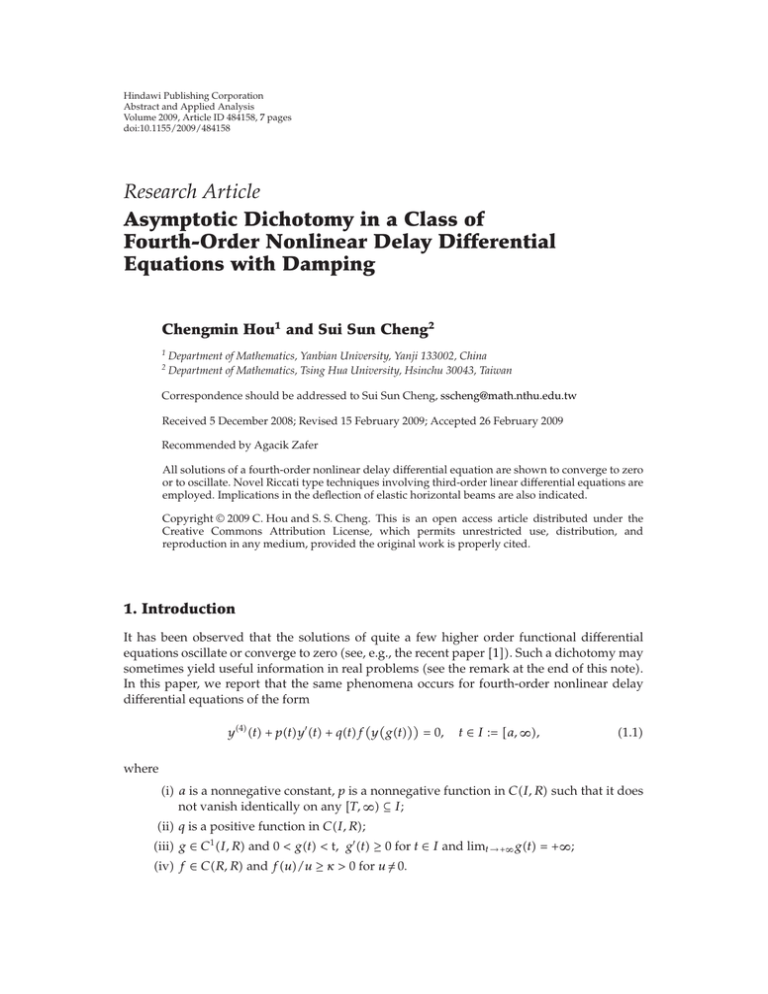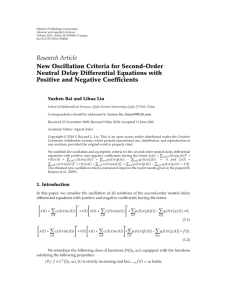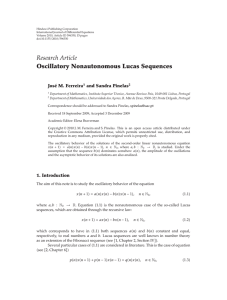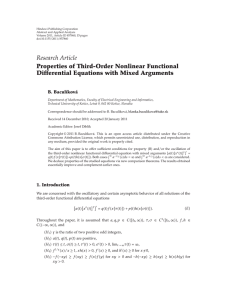Document 10817473
advertisement

Hindawi Publishing Corporation
Abstract and Applied Analysis
Volume 2009, Article ID 484158, 7 pages
doi:10.1155/2009/484158
Research Article
Asymptotic Dichotomy in a Class of
Fourth-Order Nonlinear Delay Differential
Equations with Damping
Chengmin Hou1 and Sui Sun Cheng2
1
2
Department of Mathematics, Yanbian University, Yanji 133002, China
Department of Mathematics, Tsing Hua University, Hsinchu 30043, Taiwan
Correspondence should be addressed to Sui Sun Cheng, sscheng@math.nthu.edu.tw
Received 5 December 2008; Revised 15 February 2009; Accepted 26 February 2009
Recommended by Agacik Zafer
All solutions of a fourth-order nonlinear delay differential equation are shown to converge to zero
or to oscillate. Novel Riccati type techniques involving third-order linear differential equations are
employed. Implications in the deflection of elastic horizontal beams are also indicated.
Copyright q 2009 C. Hou and S. S. Cheng. This is an open access article distributed under the
Creative Commons Attribution License, which permits unrestricted use, distribution, and
reproduction in any medium, provided the original work is properly cited.
1. Introduction
It has been observed that the solutions of quite a few higher order functional differential
equations oscillate or converge to zero see, e.g., the recent paper 1. Such a dichotomy may
sometimes yield useful information in real problems see the remark at the end of this note.
In this paper, we report that the same phenomena occurs for fourth-order nonlinear delay
differential equations of the form
y4 t pty t qtf y gt 0,
t ∈ I : a, ∞,
1.1
where
i a is a nonnegative constant, p is a nonnegative function in CI, R such that it does
not vanish identically on any T, ∞ ⊆ I;
ii q is a positive function in CI, R;
iii g ∈ C1 I, R and 0 < gt < t, g t ≥ 0 for t ∈ I and limt → ∞ gt ∞;
iv f ∈ CR, R and fu/u ≥ κ > 0 for u /
0.
2
Abstract and Applied Analysis
As is well known, fourth-order differential equations can be used to model the
deflection of a beam in particular, the function yt in 1.1 may be interpreted as the
deflection from the equilibrium position of a horizontal beam at the spatial coordinate t.
Therefore, a short note reporting our observation may be of interest in the qualitative theory
of fourth-order differential equations. Indeed, in this note, we will distinct ourselves by
emphasizing the role played by the function p in 1.1, since the term pty t acts as a control
of the slope of the beam under consideration at the coordinate t.
We will restrict our attention to those solutions of 1.1 which exist on I and satisfy the
condition sup{|yt| : T ≤ t < ∞} > 0 for any T ∈ I. Such a solution is called oscillatory if it
has arbitrarily large zeros, and nonoscillatory otherwise.
Lemma 1.1. Assume that x ∈ Cn I, R such that xt > 0 for t ≥ a and xn t is nonpositive
for t ≥ a and does not vanish identically on any T, ∞ ⊆ I. If n is even (or odd), then there exists
l ∈ {1, 3, . . . , n − 1} (resp., l ∈ {0, 2, . . . , n − 1}) such that for all sufficiently large t, xtxj t > 0
for j 0, 1, . . . , l, and −1nj−1 xtxj t > 0 for j l 1, l 2, . . . , n − 1. Furthermore,
n−l−1 l−1
n−1 x gt ≥ g tt − gt
t
x
2l−1 l − 1!n − 1 − l!
1.2
for all sufficiently large t, where g ∈ C1 I, R satisfies 0 < gt < t, g t ≥ 0 and limt → ∞ gt ∞.
Proof. The existence of l in the above result is due to Kiguradze and is well known see, e.g.,
2. Next, we will prove the inequality 1.2 for even n the odd case being similar as follows
cf. 3. First we may assume that there is a T > 0 such that xt > 0, x t > 0, . . . , xl t >
0, −1nl xl1 t > 0, . . . , −12n−2 xn−1 t > 0 for t ≥ T. By Taylor’s formula, we have
x s x T x T s − T · · · xl s∗ xl s∗ s − T l−1 ≥
s − T l−1 ,
l − 1!
l − 1!
1.3
where T ≤ s∗ ≤ s. Furthermore,
x s ≥
xl s
s − T l−1 ,
l − 1!
s ≥ T,
1.4
since xl1 t < 0 for t ∈ T, ∞. Next, we pick T1 ≥ T such that 1 − T/gt > 1/2 for t ≥ T1 .
Then gt > 2T and
l−1
xl gt l−1
g l−1 t
T
x gt ≥
g t 1 −
xl gt ,
≥ l−1
gt
l − 1!
2 l − 1!
t ≥ T1 .
1.5
By Taylor’s formula again, we get
xn−1 t∗ xl gt xl t −1xl1 t t − gt · · · −1n−l−1
t − gtn−l−1 ,
n − l − 1!
1.6
Abstract and Applied Analysis
3
here gt ≤ t∗ ≤ t. Hence
xn−1 t∗ xn−1 t
t − gtn−l−1 ≥
t − gtn−l−1 .
xl gt ≥
n − l − 1!
n − l − 1!
1.7
Combining 1.7 and 1.5, we see that
x gt ≥
g l−1 t
xn−1 tt − gtn−l−1
2l−1 l − 1!n − l − 1!
1.8
for all large t.
Lemma 1.2. Suppose the linear third-order differential equation
z ptz 0,
t∈I
1.9
has an eventually positive increasing solution on I and y is a nonoscillatory solution of 1.1 on I.
Then there exists t0 ∈ a, ∞ such that yty t > 0 or yty t < 0 for t ≥ t0 .
Proof. Without loss of generality, we may assume that yt > 0 and ygt > 0 for t ≥ a. Then
xt −y t is a solution of the third-order delay differential equation
x ptx qtf y gt ,
t ≥ a.
1.10
We claim that, all solutions of 1.10 are nonoscillatory so that y t is eventually positive or
eventually negative. To see this, let z be the solution of 1.9 such that zt > 0 and z t > 0
for t ≥ a. Then from Lemma 1.1, we have z t > 0 for t greater than or equal to a positive
number t1 .
Suppose to the contrary that x is an oscillatory solution of 1.10. We assert that s x z − xz oscillates. Indeed, since x is oscillatory, for any T > a, there are b and c such that
T ≤ b < c, xb xc 0, x b ≥ 0 and x c ≤ 0. Hence sb x bzb ≥ 0 and
sc x czc ≤ 0. If sb 0 or sc 0, then either b or c is a zero of s in T, ∞.
Otherwise, sb > 0 and sc < 0 so that there is d ∈ b, c such that sd 0. These show that
s has arbitrarily large zeros.
Now that s is oscillatory, either st ≤ 0 for all t ∈ t1 , ∞ or else there are strictly
increasing and divergent sequences {bn } and {cn } such that st > 0 for t ∈ bn , cn ⊂
t1 , ∞, sbn scn 0, s bn ≥ 0 and s cn ≤ 0.
Suppose the former case holds. Then there are b, c ⊂ t1 , ∞ such that st ≤ 0 for
t ∈ b, c and s b ≥ 0 and s c ≤ 0. From 1.9 and 1.10, we have
z
z
zqtf y gt x z − z x s − s s,
z
z
1.11
z s
s
qtf y gt − 2 .
z
z
1.12
or,
4
Abstract and Applied Analysis
Hence we have
0≥
c
b
s t
zt
dt c
b
z tst
dt > 0,
qtf y gt −
z2 t
1.13
which is a contradiction.
Suppose the latter case holds. From 1.9 and 1.10, we have
x z − z x pt xz − x z z qtf y gt ,
1.14
from which by
z z s − s ,
z
z
1.15
− pts z qtf y gt .
1.16
x z − z x we obtain
z z
s − s
z
z
Since z t > 0, s cn ≤ 0, s bn ≥ 0, scn sbn 0, st > 0, t ∈ bn , cn , we see that
cn
0<
z tqtf y gt dt
bn
cn bn
z t
z t s t −
st
zt
zt
z cn z bn s cn −
s bn −
zcn zbn − ptst dt
1.17
cn
ptstdt
bn
≤ 0,
which is a contradiction.
2. Asymptotic Dichotomy
We are now ready to state and prove our main result.
Theorem 2.1. Suppose that
i equation 1.9 has an eventually positive increasing solution z on a, ∞,
ii there is a differentiable function ρ : a, ∞ → 0, ∞ such that
t κρsqs −
lim sup
t→∞
T
for every T ≥ a,
l − 1!3 − l!ρ s2
23−l g l−1 ss − gs3−l g sρs
ds ∞,
l 1 and 3,
2.1
Abstract and Applied Analysis
5
iii
t s
lim sup
t→∞
T
κqu − pu du ds ∞.
2.2
T
Then every solution y of 1.1 either oscillates or converges to 0.
Proof. Let y be a solution of 1.1 which does not converge to 0. Suppose to the contrary that
y is a nonoscillatory solution of 1.1. Without loss of generality, we may assume that yt > 0
and ygt > 0 for t ≥ a. Furthermore, by Lemma 1.2, there is t0 ≥ a such that y t > 0 or
y t < 0 for t ≥ t0 .
Suppose y t > 0 for t ≥ t0 . Then by 1.1,
y4 t −pty t − qtf y gt < 0,
t ≥ t0 .
2.3
By Lemma 1.1, we may suppose further that y t > 0 and 1.2 holds for t ≥ t0 as well. Let
ωt :
ρty t
> 0,
y gt
t ≥ t0 .
2.4
Then by 1.1 and 1.2, we see that
ρty ty gt g t
ρ t
ωt −
ω t ≤ −κρtqt ρt
y2 gt
ρ t
g l−1 tt − gt3−l g t 2
ωt − l−1
ω t
ρt
2 l − 1!3 − l!ρt
2
g l−1 tt − gt3−l g t
2l−1 l − 1!3 − l!ρ t
−κρtqt − l−1
ω−
2 l − 1!3 − l!ρt
2g l−1 tt − gt3−l g t
≤ −κρtqt 2.5
2
l − 1!3 − l! ρ t
23−l g l−1 tt − gt3−l g tρt
2
l − 1!3 − l! ρ t
≤ − κρtqt −
,
23−l g l−1 tt − gt3−l g tρt
t ≥ α.
Hence
t κρtqt −
t0
≤−
t
2
l − 1!3 − l! ρ t
23−l g l−1 tt − gt3−l g tρt
ω sds ωt0 − ωt ≤ ωt0 t0
for all t ≥ t0 , which is contrary to our assumption 2.1.
ds
2.6
6
Abstract and Applied Analysis
Suppose y t < 0 for t ≥ t0 . Since y is eventually positive, eventually decreasing,
and does not converge to 0, we easily see that i y cannot be eventually nonpositive, ii
limt → ∞ yt λ > 0, iii limt → ∞ y t 0, and iv there is α ≥ a such that −y t < λ < yt
for t ≥ α.
In view of i above, either y is oscillatory or y is eventually nonnegative. If y is
oscillatory, then y is also oscillatory. Hence there exists some number β ≥ α such that
y β 0 and ygt ≥ λ for t ≥ β. From 1.1 and 2.2, we have
y t −
t
t
f y gs
κqs − ps ds.
y gs qs
ds − psy sds ≤ −λ
y
gs
β
β
β
t
2.7
It follows that
t s
y t ≤ y β − λ
β
κqu − pu du ds.
2.8
β
Since the right-hand side tends to −∞ as t tends to ∞, y is eventually negative which is
contrary to our assumption on y .
As a consequence, we must have yt > 0, y t < 0 and y t ≥ 0, say for t ≥ α ≥ a.
There are three cases to consider:
Case 1. If y t ≥ 0 and does not vanish identically for t ≥ α, then y t > 0 for all large t, a
contradiction. If y t ≡ 0 for t ≥ α, then y is a linear function. Since limt → ∞ y t 0, we get
y t 0 for t ≥ α, which is contrary to our assumption that y t < 0 for t ≥ α.
Case 2. If y t ≤ 0 for t ≥ α, then from 1.1, we get
y α − y t t
qsf y gs ds α
t
t
psy sds ≥ λ
α
t s
0 ≥ −y t ≥ −y α λ
α
κqs − ps ds,
α
2.9
κqτ − pτ dτ ds,
α
which is contrary to 2.2.
Case 3. If y oscillates, then 2.8 holds so that y is eventually negative, which is contrary to
our assumption on y . This completes the proof.
3. Remarks and Example
We remark that the condition 2.2 in the above result can, in case p is differentiable, be
replaced by the alternate condition
t
κqu − p u du ∞
lim sup
t→∞
T
3.1
Abstract and Applied Analysis
7
for every T ≥ 0. Indeed, we only need to note that
t
qsf y gs ds γ
t
y gs
γ
t
≥λ
t
psy sds
γ
t
f y gs
t
qs
ds psys|γ − ysp sds
y gs
γ
3.2
κqs − p s ds − p γ y γ ,
γ
where γ α or β, and then we may follow the rest of the above arguments.
Example 3.1. Consider the fourth-order delay differential equation
y
4
3π
1
1
1
y t−
0,
y 2 1−
3
tln t − 1
2
t ln t − 1
t
t>
3π
.
2
3.3
Here, pt 1/t3 ln t − 1, qt 1/t2 1 − 1/tln t − 1, and fu u with κ 1. It is clear
that 2.2 is satisfied. The equation z 1/t3 ln t − 1z 0 has an eventually positive and
eventually increasing solution z tln t − 1. By choosing ρt t and any large T, we have
t 1
1
l − 1!3 − l!
ds ∞,
s−
−
lim sup
s2 s3 ln s − 1
t→∞
23−l ss − 3π/2l−1 3π/23−l
T
l 1 and 3.
3.4
Consequently, condition 2.1 is satisfied. Hence by Theorem 2.1, any solution of 3.3 is
oscillatory or satisfies limt → ∞ yt 0.
As our final remark, suppose we have a sufficiently long elastic horizontal beam
modeled by 1.1. Our Theorem says that under appropriate conditions if the right end of
the beam is fixed at some nonzero vertical position, then there must be places where there
are positive as well as negative displacements of the beam from its equilibrium position. This
shows that the dichotomy in our Theorem has implications in the elastic beam deflection
problem.
References
1 A. Tiryaki and M. F. Aktaş, “Oscillation criteria of a certain class of third order nonlinear delay
differential equations with damping,” Journal of Mathematical Analysis and Applications, vol. 325, no.
1, pp. 54–68, 2007.
2 G. S. Ladde, V. Lakshmikantham, and B. G. Zhang, Oscillation Theory of Differential Equations with
Deviating Arguments, vol. 110 of Monographs and Textbooks in Pure and Applied Mathematics, Marcel
Dekker, New York, NY, USA, 1987.
3 Z. G. Ouyang and Y. K. Li, “Monotone solutions of even-order delay differential equations,” Journal of
Mathematical Research and Exposition, vol. 24, no. 2, pp. 321–327, 2004.









